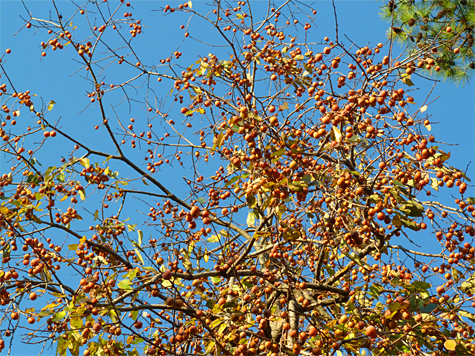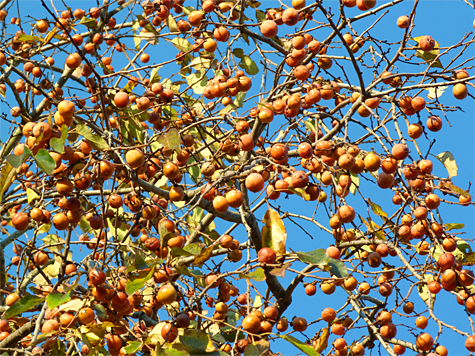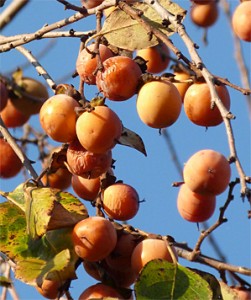If you walk out of the doors leading to Loblolly Park here at the Museum, and look up, you will see a persimmon tree chock-full of persimmons.

The tree before you has done well this year. Other persimmons on campus did not fare so well. One tree located on the boardwalk leading to the Wetlands lost nearly all of its fruit during the summer when the fruit was about 3/4 inch across and green. I can’t even guess why the fruit fell to the ground that early in the season, but whatever the reason, that tree is now bare.
The tree in Loblolly Park is overloaded with fruit. But what can you do with so many persimmons? I don’t advise rushing outside, grabbing one and taking a bite, they don’t appear to be completely ripe yet. Persimmons need to be ripe, very ripe, before you eat them. I’ve tried one, they’ll suck the moisture out of your mouth like a ShamWow. The bitter, moisture sucking taste is due to tannin in the fruit. Besides, there’s too many persimmons on this tree to eat them all, even if you could tolerate them in their present state.

It’s surprising to me how few people know what a persimmon is let alone know about its bad tasting pre-ripe characteristics. The warnings against prematurely consuming the fruit before it has fully ripened have been around a long time. The Powhatans of Virginia warned John Smith’s people about the fruit’s unexpected bitter taste.

Here’s what Capt. Smith had to say about this strangely unfamiliar fruit. “The fruit is like a medlar [a tree in the rose family whose fruit can only be eaten when fully ripened, or squishy]; it is first green then yellow, and red when ripe; if not ripe, it will drive a man’s mouth awrie with much torment; but when it is ripe, it is as delicious as an apricock.”
The name persimmon itself comes from the Powhatan language and supposedly means “dry fruit” or “he who dries fruit” or “artificially dried fruit” depending upon what source you consult and, apparently, what root you use, putchamin, pasiminan, or pessamin (not necessarily in that order).
So, the question still is, what do you do with them? Well, first let them ripen completely until they are very soft, then, you can make muffins, cake, pie, put them in your pancakes, make bread, pudding, cookies, put ’em in fruit salad, salsa, make smoothies, frozen persimmon pops, persimmon butter, persimmon cream, more persimmon cookies, cakes and muffins and bread…but let them ripen first!
Oh yeah, if you do make any of the above items, I’d be happy to taste test them for you. Persimmon muffins and bread sound especially appealing to me.
One of my all time favorite metaphors: “they’ll suck the moisture out of your mouth like a ShamWow!” Sheesh! I don’t want ANY part of that! I’ll wait for Emily to make muffins! 😉
Hear that, Emily? We’re all waiting.
Anybody out there bake bread?
Maybe the women who made the pie will return!
Many years ago, a guest, a pregnant guest, was craving persimmon pie and asked if she could gather fruit for our Loblolly tree. We were happy to share.
Do any groundhogs, squirrels, foxes or birds also show up to eat the persimmons?
You betcha!
All of the above. In fact, it’s a common sight during the fall and early winter to see fox and raccoon scat laced with persimmon seeds. I don’t think the squirrels actually eat the seeds, but look here at this one with a partially eaten persimmon in its mouth: /2011/09/14/fall/ and scroll down.
I’m fairly sure that most birds just eat the flesh. But yes, they all partake.
I’ll be keeping a sharp eye on that tree! I may not be able to eat them all, but I’ll gladly give it the old college try.
When ripe, they should fall from the tree on their own. Of course, the fall to the ground may splatter them beyond use since they’ll be very soft and mushy at that time, so you better be there when it happens. Maybe a net placed beneath the tree to gently catch the ripe persimmons as they fall is the way to go.
Did I just catch a whiff of hot muffins?